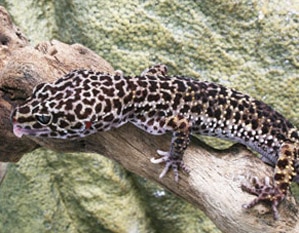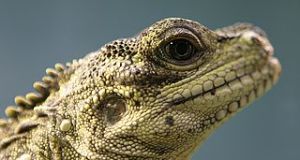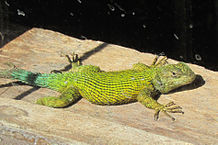Breeding Leopard Geckos (Eublepharis macularius) at Home: Determining the Sex of Your Pets
 The ever popular leopard gecko is a good choice as an introduction to the breeding of lizards in captivity. Success, while not assured, is common…yet, these little fellows are so captivating that even zoos and well-experienced breeders continue to work with them.
The ever popular leopard gecko is a good choice as an introduction to the breeding of lizards in captivity. Success, while not assured, is common…yet, these little fellows are so captivating that even zoos and well-experienced breeders continue to work with them.
Spring’s Effect
Leopard geckos are often brought into breeding readiness by the slight changes in temperature and day length that are evident even indoors. With the imminent arrival of spring (writing from southern NY I am happy to report hearing a song sparrow singing for the first time today!), I thought it a good time to discuss how female from male leopard geckos differ in appearance.
The Pores
Take a look at your pet’s vent, which is an opening, used for copulation and defecation, at the base of the lizard’s tail. Directly above the vent, between the rear legs, you will see a series of “V” shaped little bumps, which are known as pre-anal pores. These are large and readily visible in males and tiny and less-evident in females. The pores produce waxy secretions that are used by males to mark territories and, possibly, to attract females.
Hemipenes
Between the vent and the base of the tail, mature male geckos exhibit a pair of bulges. These bulges conceal the hemipenes, which are used during copulation to achieve internal fertilization. Male lizards and snakes have 2 hemipenes, and can use either, but only one at a time, when mating.
Practice!
You may need to look at a number of geckos, or reliable photographs, before being able to reliably distinguish males from females…but once you get the right “search image” the process becomes quite easy. Please remember that only mature animals – males of age 1 year or more, females generally of age 18 months or so – will exhibit noticeable sexual dimorphism (differences in appearance).
Further Reading
Please check out the book I’ve written on leopard gecko care and natural history at http://www.thatpetplace.com/pet/prod/240453/product.web.
 That Reptile Blog – Reptile, Amphibian and Exotic Pet Care and Information
That Reptile Blog – Reptile, Amphibian and Exotic Pet Care and Information




Leopard Geckos and Fat tail geckos seem so similar. Can they be kept together? Will they interbreed?
Great post. Another point to make a leopard gecko should be fully grown before breeding and it’s best that they are at least a year old. If the gecko female is too young it is possible that a complication could arise, and the lifespan can be reduced.
Interesting! the ideal age for breeding is closer to 10 months but to be on the safe side, the female leopard gecko should be bred at around the age of approximately 12 months.
Hello Michael, Frank Indiviglio here.
Thanks for your interest in our blog. I’m planning on writing an article on breeding details shortly – age, methods, etc., to complement this article on differentiating the sexes.
Captivity changes the natural order of things, of course, and certain females are ready by 12 months of age. Weight is a very good indication of breeding readiness; egg production is quite draining – a female that is sexually mature yet small in size may have difficulties. A weight of 40 grams or so is generally considered to be safe, although particularly cautious breeders sometimes prefer to use females of 50-60 grams in weight.
Some breeders, especially those with commercial operations, hold back the females until they are age 18-24 months, just to be on the safe side.
Best regards, Frank Indiviglio.
I have two female leopard geckos and I have been trying to convince my mom to let me breed them (I am only 13 so I have little say in it) but she said that they could lay eggs that are not fertile, without the presence of a male, under the right conditions, and if that happened I could breed them. Is this even possible? If so is it safer to breed them when or if it happens? I know some lizards do this since I had a teacher that thought her iguana was a male until it laid eggs and it was the only one in the cage.
Hello Taylor, Frank Indiviglio here. Thanks for your interest in our blog. I apologize for the long delay in responding to you…an emergency surgery put me out of commission for a time.
A great many female reptiles, including leopard geckos, will lay eggs even if no male is present. However, the eggs laid by your lizards will not hatch. Many times they will not lay at all, but rather will absorb the eggs back into their bodies.
Amazingly, females of several reptile species can produce young without the presence of a male. This process is known as parthenogenesis, and seems to be a type of “cloning”. In flowerpot snakes and whiptail lizards, only females of the species are known – males have never been found. Recently, parthenogenesis was also discovered in the Komodo dragon, which seems very odd as both males and females do exist – we have a lot more to learn (if you start your research now, I may someday read about your new discoveries!). Parthenogenesis is also surprisingly common in fishes, and in insects and other invertebrates.
Please check out my article on Flowerpot Snakes if you’d like to read a bit more on the topic.
Good luck and please write in if you need more information.
Best regards, Frank Indiviglio.
Hi Frank,
Question for you regarding leopard geckos’. I just came across an article on Death in leopard geckos following ingestion of vermiculite.
Now I’ve always used vermiculite for my hide boxes in my various tanks, it seems to do the best at keeping the humidity nice, the geckos really seem to like it.
But after reading this article I’m a bit concerned I’m wondering if I should just go back to using eco earth or some type of soil just making sure it’s damp everyday. In your experience have you ever witnessed such behavior with any of the leopard gecko’s you’ve kept?
As Always.. Thanks.
-Dave
Hello Dave, Frank Indiviglio here.
You raise an interesting question, thanks. Vermiculite is a fine egg-incubation medium but I have not used it as a substrate for leopard geckos. I think there would be the potential for impaction problems, if any were swallowed along with the lizard’s food, as vermiculite absorbs water well and increases in size rapidly. Vermiculite in a hide box is less of a concern, unless insects were to crawl into the area and be consumed there.
Good luck and please keep me posted.
Best regards, Frank Indiviglio.
Hi Frank,
Thanks for your reply, I generally only use vermiculite in my hide boxes. I use cage carpet or playsand for general substrate, do you have any other suggestions for something else I can try in the hide boxes? Thanks.
-Dave
Hello, Frank Indiviglio here. Thanks for your note.
Cypress Mulch is a good choice for leopard gecko and similar species’ hide boxes. You can fine tune the humidity easily by spraying with water and it is not likely to be swallowed.
Even if it becomes too damp, cypress does not readily support the growth of fungi and mold – a very important consideration where arid-adapted reptiles are concerned. In zoos we spread similar products below heavily used bird/mammal feeders, for the same reason.
Good luck and please keep me posted.
Best regards, Frank Indiviglio.
I was just wondering if you have any lepord geckos for sale or if you could tell me were get to them and how much they would cost.~thanks:)
Hello Cassandra, Frank Indiviglio here. Thanks for your interest in our blog.
We carry a wide variety of leopard geckos of varying ages and color phases at That Fish Place/That Pet Place. If you are near Lancaster, PA, please stop by…our reptile room staff will happily assist you in picking out your new pet.
Otherwise, leopard geckos can be purchased via inter net dealers, or at any of the numerous “reptile shows” (private dealer sales) that are held in nearly all states. Prices vary widely depending upon age, color phase, season and a host of other factors.
When you have a moment, please also check out the book I’ve written: Leopard Gecko, Your Happy, Healthy Pet.
Enjoy, Good luck and please keep me posted.
Best regards, Frank Indiviglio.
i was wondering if i could use moss as a incubating and substrate for my leopard gecko. i had paper towles in mind but im not sure if i should use paper towles anymore, because i heard moss and vermiculite act as good hide. if i ever have to incubate what do you have in mind? =)
Hello Sam, Frank Indiviglio here.
Thanks for your interest in our blog.
I prefer vermiculite… being non-organic (it is heat-treated mica, a mineral) it supports little fungal growth. A 1.5 to 1 ratio of substrate to water works well. 1 ml. of water weighs 1 gram, so it’s easy (even for the mathematically challenged, such as I!) to calculate the correct mix. Please be in touch when you get eggs and I’ll go through it with you.
Good luck, enjoy and please keep me posted.
Best regards, Frank Indiviglio.